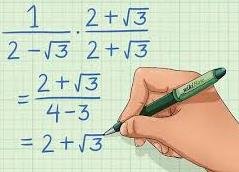Rationalizing denominators is a mathematical technique used to eliminate radicals from the denominator of a fraction. Radicals are mathematical expressions like square roots or cube roots. The goal of Rationalizing the denominator is rewriting the expression so that the denominator no longer contains a radical. This makes it easier to work with the expression, especially in further mathematical operations.
By applying denominator Rationalization, mathematicians and students can simplify complex problems and make further calculations easier
Importance of Rationalizing denominators
- Simplification: Rationalizing the denominator simplifies expressions, making them easier to read, understand, and perform operations with.
- Standard Form: Many mathematical conventions prefer fractions without radicals in the denominator.
- Mathematical Consistency: It provides a more uniform form of expression, especially when comparing multiple fractions.
Steps involved in Rationalizing denominators
Rationalizing a Single Radical: If the denominator is a simple square root for example;
multiply both the numerator and denominator by the same square root. This eliminates the square root in the denominator because multiplying two square roots gives the number under the root. Example:
Now, the denominator is a rational number
Rationalizing Denominators with a Binomial
If the denominator contains a binomial (a sum or difference involving radicals, such as:
To rationalize the above binomial, we proceeds:
This rationalizes the denominator while simplifying the fraction.
When a surd of order two is squared, a rational product is obtained. For example:

When we have a fraction with surds in the denominator, we can remove the surd in the denominator by multiplying it with a surd that will make the irrational denominator become rational.
The process involves multiplying an irrational denominator with another irrational denominator. This makes it rational. It is known as rationalizing the denominator.
For example:

please not that multiplying by

is by multiplying by 1. Hence the value has not changed in the fraction.
Multiplying a number by one does not change it’s value.
To rationalize the denominator of a fraction containing a surd (a radical expression), you want to eliminate the surd from the denominator or express it in a form where the denominator does not contain a radical. The steps includes:
i. Identify the surd in the denominator:
Look for the square root or other radical expression in the denominators
ii. Multiply both the numerator and the denominator by a suitable expression:
This expression should eliminate the radical from the denominator. To do this, multiply by the conjugate of the denominator, which is the same as the denominator but with the sign between the terms flipped.
For example, if the denominator is √a + b, then its conjugate is √a – b.
iii. Simplify the expression:
Multiply the terms in the numerator and denominator and combine like terms if possible.
iv. Check for further simplification:
Sometimes, after rationalizing the denominator, you may be able to simplify the resulting expression further by factoring or simplifying.
Example
Rationalize the denominators in

solution
(a)

(b)

Note: as you can see from the above workings, the irrational value in the denominator has been removed. Hence, we have rationalized the denominator.
Expanding the product

as shown above, the product of the two irrational sums have resulted to a relational number a-b.

that is :

A conjugate in surds is a surd with an expression such that the product of the two expressions results into a rational number.
One important application of conjugates is in removing of surds in denominators of surds expressions that have fractions. A denominator in the fraction is multiplied by it’s conjugate. A conjugate of a surd expression is usually the same operands whose operators has changed to the opposite sign of the other operands.
When we have removed surd expressions in the denominator, we say that we have rationalized the denominator.
Example
Rational the denominators of the following surds:

Solution
(a)

(b)

Practice Problem
Given that √3 =m, √5 and √13 =p, rationalize the denominator and express your answer in terms of n, m and p.


Leave a Reply